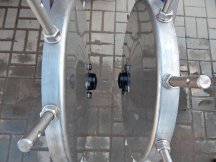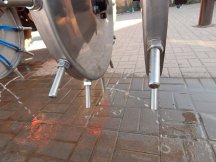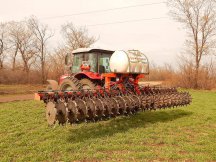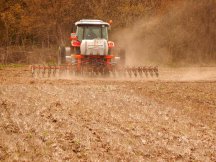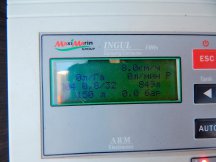UAN for winter and spring crops
Application and dosage
UAN is perhaps the most optimal solution for feeding crops. Versatility, affordability and the possibility of small-scale application for ensuring better effective results make urea-ammonia compound ablosulety indispensable on the farm.
However, like any method, plant fertilization with above mentioned type of liquid fertilizer has its dangers. In particular, these are the nnecessity of optimal weather conditions (absence of rainfall and dew before fertilization) and maximum care to prevent burns during leaf feeding, keeping to precise dosing.
In order to increase the efficiency of nutrition and prevent "side effects", we have developed the Injection Wheel Fertilizer , for application of liquid fertilizers in the soil at a pressure of 3-6 bar.
Foliar nutrition with UAN
Outroot feeding brings the most effective results if applied in conditions of cloudy weather but without precipitation. This is due to the fact that the substance has to remain on the leaf surface for some time in order to obtain better result.
However, the substance presence on the surface of a plant can cause burns, necrotic spots etc. Therefore, it is worth of considering the time, conditions and application rates in details.
The first feeding in spring
The temperature plays an important role during the first feeding. The thermometer column should reach 5-10 ° C. Application is safe even up to 100 kg / ha.
The second feeding
In this period some application rate warnings exist. The dose should not exceed 20-30 kg / ha. The temperature should not be lower than 18 ° C. It should also be noted that while the second feeding the risk of burns increases, so it is appropriate to dilute the mixture with water. One part of the mixture for two parts of water. This treatment often coincides with the terms herbicides application, treatment against pests and diseases. UAN is easy to combine with other plant protection agents, but it requires more water.
The ratio is 1: 3.
Application of retardants in combination with UAN
It is recommended to carry the application of UAN in combination with growth regulators at the beginning of stem extension period. In this case the amount of nitrogen should not exceed 40 kg / ha. The gradual reduction of the dose is explained by the fact that a plant consumes the highest amount of nitrogen namely during the first feeding. For example, before earing the amount should be reduced to 10 kg / ha.
Effective combinations and rates UAN application
The simultaneous application of UAN and plant protection products first of all depends on the plant condition, necessity of additional nutrition and enterprise capacities.
Spring feeding should be primarily carried in the places where the necessity of increasing tillering exists. The amount of nitrogen is determined by the condition of the processed plant, precursor plant, soil etc. The crops with plant density of 200-300 pcs per square meter require from 50 to 80 kg / ha.
In the stem extension phase of winter crops UAN + Fundazole is used in the following quantities: UAN - up to 40 kg / ha, Fundazole - 0.5 kg / ha.
UAN + growth regulators are also used at the beginning of stem extension period. In combination with chlorine chloride, UAN is highly productive in processing winter wheat, while the combination with Camposan is more suitable for use on rye fields.
As the main fertilizer, UAN has shown the most effective result when applied to barley. At the same time in case of foliar feeding, the amount of UAN must not exceed 15-20 kg / ha. It should also be noted that in the undiluted form UAN can cause yield decrease by 4-4,5 c / ha..
Application of UAN and other plant protection products with the help of Injection Wheel Fertilizer.
1. The possibility of moving wheels ensures both the most accurate selection of necessary working width and precise application.
2. Owing to the computer control of application rates it is possible to achieve the exact amount of solution per hectare that ensures uniform application throughout the whole area.
3. Application is carried into the depth of 6-8 cm, so that the needle reaches moisture and ensures better nutrition without the risk plant leaves burning.





